|
posted by HealthWrights on
THIS PAGE |
|
Jesús is a 9 year old boy with cerebral
palsy. He was first brought by his mother, Lupita, to the PROJIMO community
rehabilitation center in Coyotitan, Mexico, in early 2009. Eventually his
mother -- who is single and very poor -- became the program's cook, and she
moved there with Jesus and his 3 year old sister. At first Jesus was
withdrawn and spoke very little. The level of his intelligence was unclear.
But little by little, as he was befriended by other children and integrated
into the group, the boy began to speak more. Today he is a happy and
adventurous child, eager to learn new skills. This is picture story of one
aspect of the boy's progress at PROJIMO. Jesus' rehabilitation has been made
possible through assistance from Stichting Liliane Fonds in Holland. [Photos
and slideshow by David Werner, advisor to PROJIMO. December 2009. For more
information contact healthwrights@igc.org] |
| |
|
|
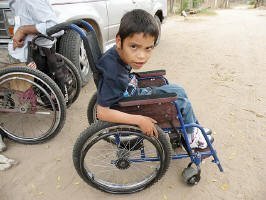 |
 |
 |
|
At PROJIMO -- a community-based rehabilitation program in
rural Mexico run by disabled villagers --Jesus, who has cerebral palsy,
learned to use a wheelchair. His legs are weak and distonic. but he has
fair control of his arms and hands. His dream is to learn to walk, be it
with a walker or crutches. Whether he will achieve this goal is uncertain.
But in the meantime there're lots of other things he can learn. |
Jesus' uneven muscle tone causes him to constantly slump
forward and to one side. It takes a concerted effort to raise his head and
sit up straight. |
This wheelchair, made by
disabled workers in the PROJIMO Duranguito wheelchair shop, helps the boy
sit straighter -- but it is still a struggle. |
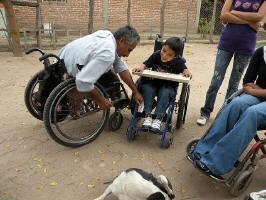 |
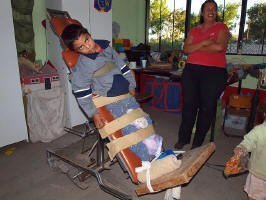 |
 |
| Raymundo, leader of the
Duranguito shop, makes some final adjustments to Jesus' chair. |
Berenice, a therapy assistant at
PROJIMO, helps Jesus stand upright on a standing frame. |
But even when strapped in place,
Jesus' head and shoulders soon slump far to one side and forward. He needs
constant stimulation to keep his head upright. |
 |
 |
 |
| Virginia, a member of the
PROJIMO team, helps Jesus learn to draw and play games on a computer. The
boy makes a big effort to hold his head up so he can watch the screen. |
The use of the computer helps
Jesus with both head control and hand-eye coordination. His coordination and
self-confidence grew rapidly.
|
Despite his efforts, Jesus' head
sometimes starts to sag. But his excitement increases his muscle tone and
helps him straighten up again. |
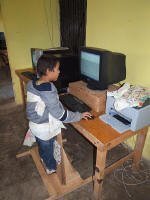
|
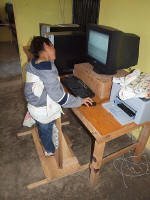 |
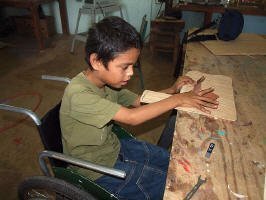 |
| The PROJIMO-Coyotitan team
designed a standing frame for Jesus to use the computer, which is raised to
help him lift his head. |
However, with his muscle
imbalance and low tone, Jesus' hips (pelvis) began to flop out to the right
side, increasing the leftward tilt of his trunk and head. The hip displacement
also caused knee pain, and the boy began to whimper. Adjustments were
urgently needed. |
Jesus took part in modifying his
standing frame. Here he sands a support that will be attached (with padding)
to the frame, to keep his hips from shifting to the side. |
 |
 |
%20helps%20out[1]_small.jpg) |
| Jesus and Moises, a boy with
spina bifida, nail the hip-stabilizer to the walking frame, while Jesus'
mother, Lupita, holds the frame in place. |
Involvement of disabled children
and the family in designing and making their own assistive equipment gives
them a sense of pride and control over their rehabilitation. |
Nemias, a 17-year-old youth
from Guatemala who came to PROJIMO for a prosthesis after he lost a leg
hitching a ride on a train, gives the boys a hand. |
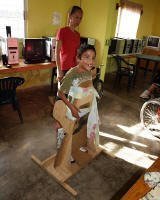 |
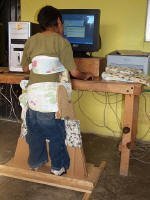 |
 |
| With the new hip stabilizer on
his standing frame, Jesus can stand much straighter -- which in turn helps
him hold his head more upright. |
Now, when Jesus plays learning
games on the computer, he stands straighter and holds his head up longer. |
Moises -- who after school helps
run the computer skills-learning center at PROJIMO, guides Jesus in learning
to read and write, using a fun-based computer program. |
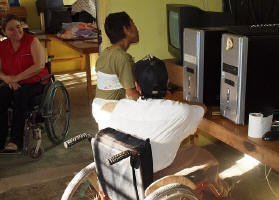 |
|
|
| Conchita, a PROJIMO leader,
watches Moises coach Jesus. Children love learning with Moises because he
respects them and enjoys helping them master new skills. He does his best to
make rehabilitation functional and fun! |
|
|
![]()